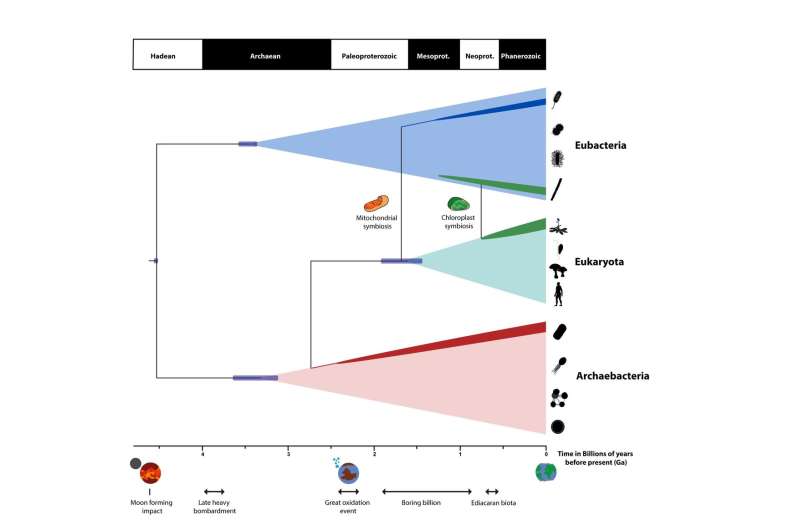A timescale for the origin and evolution of all of life on Earth

A new study led by scientists from the University of Bristol has used a combination of genomic and fossil data to explain the history of life on Earth, from its origin to the present day.
Palaeontologists have long sought to understand ancient life and the shared evolutionary history of life as a whole.
However, the fossil record of early life is extremely fragmented, and its quality significantly deteriorates further back in time towards the Archaean period, more than 2.5 billion years ago, when the Earth's crust had cooled enough to allow the formation of continents and the only life forms were microbes.
Holly Betts, lead author of the study, from the University of Bristol's School of Earth Sciences, said: "There are few fossils from the Archaean and they generally cannot be unambiguously assigned to the lineages we are familiar with, like the blue-green algae or the salt-loving archaebacteria that colours salt-marshes pink all around the world.
"The problem with the early fossil record of life is that it is so limited and difficult to interpret—careful reanalysis of the some of the very oldest fossils has shown them to be crystals, not fossils at all."
Fossil evidence for the early history of life is so fragmented and difficult to evaluate that new discoveries and reinterpretations of known fossils have led to a proliferation of conflicting ideas about the timescale of the early history of life.
Co-author Professor Philip Donoghue, also from Bristol's School of Earth Sciences, added: "Fossils do not represent the only line of evidence to understand the past. A second record of life exists, preserved in the genomes of all living creatures."
Co-author Dr. Tom Williams, from Bristol's School of Biological Sciences, said: "Combining fossil and genomic information, we can use an approach called the 'molecular clock' which is loosely based on the idea that the number of differences in the genomes of two living species (say a human and a bacterium) are proportional to the time since they shared a common ancestor."
By making use of this method the team at Bristol and Mark Puttick from the University of Bath were able to derive a timescale for the history of life on Earth that did not rely on the ever-changing age of the oldest accepted fossil evidence of life.
Co-author Professor Davide Pisani said: "Using this approach we were able to show that the Last Universal Common Ancestor of all cellular life forms, 'LUCA', existed very early in Earth's history, almost 4.5 Billion years ago—not long after Earth was impacted by the planet Theia, the event which sterilised Earth and led to the formation of the Moon.
"This is significantly earlier than the currently accepted oldest fossil evidence would suggest.
"Our results indicate that two "primary" lineages of life emerged from LUCA (the Eubacteria and the Archaebacteria), approximately one Billion years after LUCA.
"This result is testament to the power of genomic information, as it is impossible, based on the available fossil information, to discriminate between the oldest eubacterial and archaebacterial fossil remains."
The study confirms modern views that the eukaryotes, the lineage to which human life belongs (together with the plants and the fungi, for example), is not a primary lineage of life. Professor Pisani added: "It is rather humbling to think we belong to a lineage that is billions of years younger than life itself."
More information: Holly C. Betts et al, Integrated genomic and fossil evidence illuminates life's early evolution and eukaryote origin, Nature Ecology & Evolution (2018). DOI: 10.1038/s41559-018-0644-x
Journal information: Nature Ecology & Evolution
Provided by University of Bristol





















